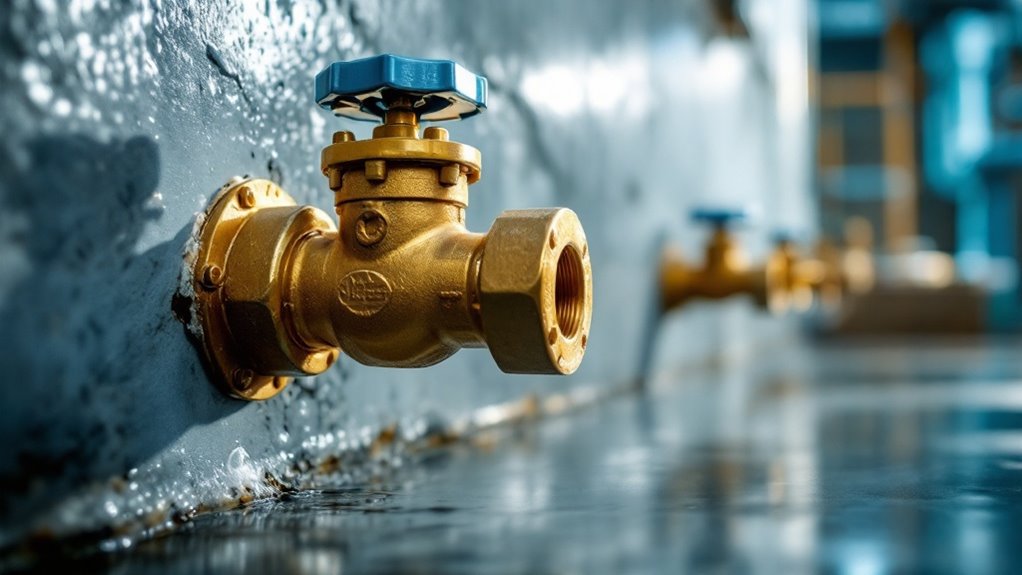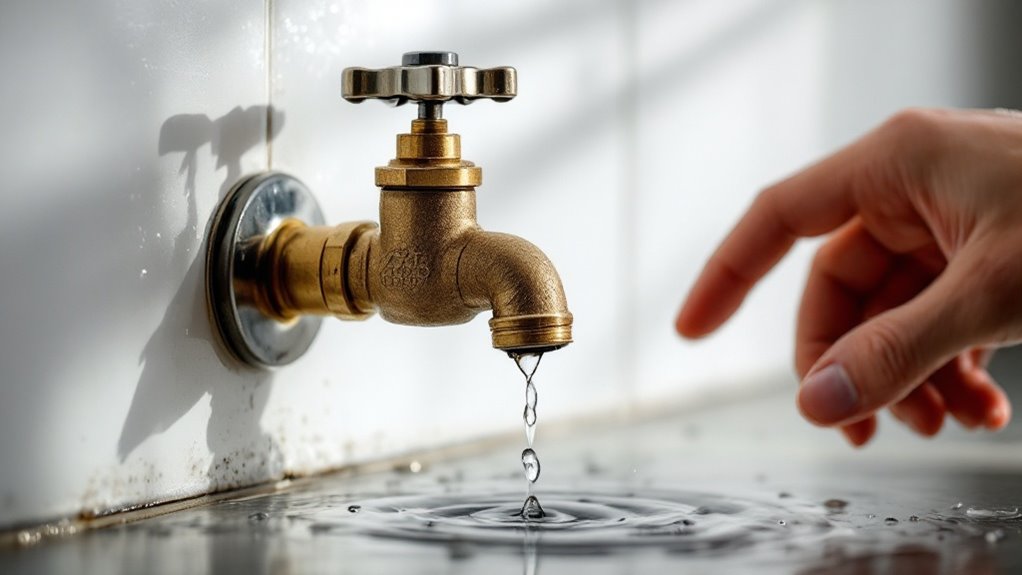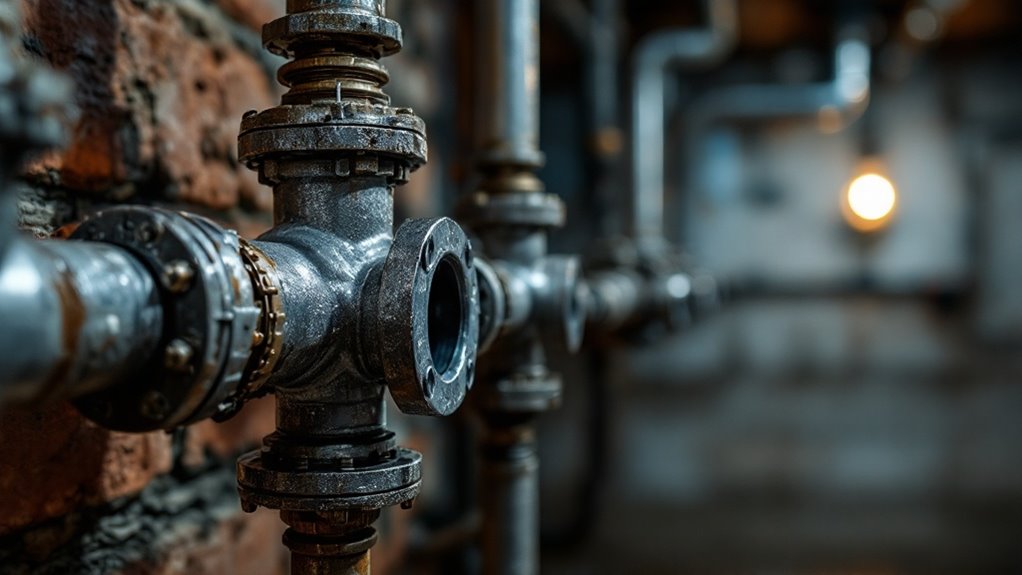When a plumbing emergency strikes, it’s like a fire alarm ringing in your home—time is of the essence. You need to act fast to minimize damage and restore order. Knowing how to shut off your water supply quickly can make all the difference. But do you know where your main shut-off valve is? Understanding its location and operation can save you from a disaster. Let’s investigate how to handle this critical situation effectively.
Key Takeaways
- Locate the main water shut-off valve, typically found in the basement, crawl space, or near the water line entry.
- Turn the valve clockwise to immediately stop water flow and prevent further damage.
- Check under sinks, toilets, and washing machines for additional shut-off valves to isolate specific areas.
- Educate household members on the location and operation of the shut-off valve for quick action during emergencies.
- Regularly inspect and maintain the valve to ensure it functions properly when needed.
Understanding Your Main Water Shut-Off Valve

When a plumbing emergency strikes, knowing how to quickly locate and operate your main water shut-off valve can save you from extensive damage. This valve is critical; it controls the flow of water into your home. Understanding its function is fundamental for preventing water-related disasters. Typically, turning the valve clockwise will shut off the water flow, while counterclockwise will open it. Don’t hesitate to practice turning it on and off, so you’re prepared in a crisis. Remember, the valve may be different depending on your plumbing system, but its role remains the same. Familiarizing yourself with this important component guarantees you can act swiftly when every second counts, minimizing potential damage and costly repairs. In addition, knowing how to locate the main water shut-off valve is essential for all homeowners to effectively manage potential plumbing emergencies.
Locating the Shut-Off Valve in Your Home
How can you quickly find the shut-off valve in your home during a plumbing emergency? Knowing its location can save you from a disastrous situation. Here are some common places to check:
- Basement: Look near the foundation wall or where the water line enters.
- Crawl Space: If you have one, the shut-off valve might be there.
- Outside: Check near the perimeter of your home, often in a covered box.
- Under the Sink: In kitchens or bathrooms, look beneath the cabinets.
- Laundry Room: The valve may be located near the washing machine.
Familiarizing yourself with these spots can help you act quickly when every second counts. Additionally, during a plumbing emergency, having access to 24/7 emergency plumbing services can significantly reduce potential damage.
How to Turn Off the Main Water Supply

To turn off the main water supply, first locate the main valve in your home. Once you find it, twist the valve clockwise to shut off the water flow completely. After that, check for any leaks to verify everything’s secure. It’s also important to assess the problem by identifying the leak source and checking water pressure.
Locate the Main Valve
Finding the main water valve is crucial during a plumbing emergency, as it can help you quickly stop any flooding or damage. Here’s how to locate it:
- Check your basement: Look near the foundation walls for a valve, often close to the water meter.
- Inspect the crawl space: If you have one, the valve may be located there.
- Search near the water heater: Many homes have valves close to this appliance.
- Examine outside: Some homes have exterior valves, often near the ground level or in a box.
- Consult your home’s blueprint: If available, it will show the valve’s exact location.
Turn Off Clockwise
When you’ve located the main water valve, it’s time to shut off the water supply by turning the valve clockwise. This action stops the flow of water to your home. Make sure you’re turning it the right way, as turning counterclockwise will keep the water running.
Here’s a quick reference table to help you remember:
| Direction | Action |
|---|---|
| Clockwise | Turn to shut off water |
| Counterclockwise | Turn to open water supply |
| Fully Closed | No water flow |
Ensure you apply firm pressure and turn until it’s fully closed. If you encounter resistance, don’t force it; you might need to use a wrench or seek professional help.
Check for Leaks
After you’ve turned off the main water supply, it’s vital to check for leaks in your plumbing system. This step helps you guarantee that no hidden issues could cause further damage. Here’s what you should do:
- Inspect visible pipes for any signs of moisture.
- Look around faucets and connectors for drips or puddles.
- Check the water meter; if it still moves, there’s a leak.
- Examine toilet tanks and bowls for leaks or running water.
- Listen for hissing sounds, which can indicate a leak in hidden areas.
Identifying Additional Shut-Off Points

Once you’ve turned off the main water supply, it’s essential to know where other shut-off points are located. Check for appliance-specific valves under sinks or behind toilets, and don’t forget about outdoor shut-off access points. Familiarizing yourself with these locations can save you time and prevent further damage during a plumbing emergency.
Main Water Valve Location
Finding the main water valve is just the first step in managing a plumbing emergency; knowing where to locate additional shut-off points can save you time and prevent further damage. Here are some common areas to check for extra valves:
- Under sinks: Look for valves beneath kitchen and bathroom sinks.
- Toilets: There’s usually a valve at the base of your toilet.
- Washing machines: Check the wall behind the machine for shut-off valves.
- Outdoor spigots: Many homes have separate valves for outside faucets.
- Water heater: There’s often a valve near the water heater for quick access.
Appliance-Specific Shut-Off Valves
While you may already know about your home’s main water valve, understanding how to identify appliance-specific shut-off valves can be crucial during a plumbing emergency. These valves are usually located close to the appliances they serve. For instance, your washing machine typically has a valve behind it, and your dishwasher often has one under the kitchen sink. You’ll likewise find shut-off valves for your toilet, usually near the base. Knowing where these valves are allows you to quickly cut off the water supply to specific appliances, minimizing damage. Regularly check these valves to verify they’re functional, and label them if necessary. This preparation can save you time and stress when a plumbing issue arises.
Outdoor Shut-Off Access Points
Along with indoor shut-off valves, outdoor access points play a crucial role in managing water supply during emergencies. Knowing where to find these valves can save you precious time when every second counts. Here are key outdoor shut-off access points to locate:
- Main Water Shut-Off Valve: Usually near your home’s foundation.
- Irrigation System Valves: Found in the garden or yard area.
- Spigot Shut-Off Valves: Located at exterior faucets.
- Pool Water Supply Valves: If you have a pool, check its plumbing.
- Backflow Prevention Devices: Often near the water meter.
Regularly inspect and label these points to make sure you can act quickly. Taking the time to familiarize yourself with them could prevent extensive water damage.
When to Call a Professional Plumber
Knowing when to call a professional plumber can save you time and prevent further damage. If you notice persistent leaks, unusual water pressure changes, or if your DIY fixes aren’t working, it’s time to reach out for help. Furthermore, if you’re facing a significant clog that won’t budge or if water is pooling in your home, don’t hesitate to contact a pro. Plumbing emergencies can escalate quickly, causing costly repairs if left unattended. Trust your instincts—if a situation feels overwhelming or you’re unsure of the next steps, a licensed plumber has the expertise to address the issue safely and efficiently. Remember, it’s better to be safe than sorry when it comes to your plumbing!
Preventive Measures for Future Emergencies
To prevent plumbing emergencies in the future, it’s essential to stay proactive about your home’s maintenance. By keeping an eye on your plumbing system, you can catch issues before they escalate. Here are some preventive measures you should consider:
- Inspect pipes regularly for leaks or corrosion.
- Clean gutters and downspouts to guarantee proper drainage.
- Know the location of your main shut-off valve and verify it’s functioning.
- Schedule regular plumbing inspections with a professional.
- Avoid pouring grease or non-biodegradable items down the drain.
Conclusion
When plumbing emergencies strike, knowing how to shut off your water fast can save you a world of trouble. By familiarizing yourself with your main shut-off valve and any additional shut-off points, you’ll be ready to act swiftly. Remember, it’s always better to be safe than sorry. If a problem’s beyond your skill level, don’t hesitate to call a professional plumber. With these tips, you’ll be well-prepared to tackle any plumbing issue that comes your way.
